The artist Louise Cherry has a note on her studio wall that reads, "a need to make sense of the inexplicable". It’s one of a series of lines she has taken from podcasts, interviews, books she has read, phrases and ideas that stuck in her mind as she was making her current body of work, All that’s left of you in me. The project began with a proposal, "to collaborate with my father again", and a feeling that she needed to go back to making more conceptual work, something she had not done since her graduate photography won critical and international acclaim in the early 2000s, and since her last solo show in 2008.
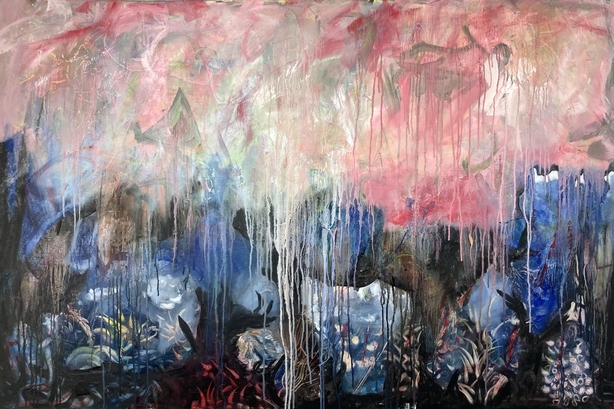
In the studio, more words pinned to the wall form a kind of mantra while offering a loose set of guidelines for proceeding: "learning to see something confusing", "sometimes what isn’t there is vital", "art resolves nothing", "anxiety is the root of mark making", "if the work doesn’t penetrate or wound in some way, then it’s failed". Cherry’s father died in 2009, following a long illness with Parkinson’s disease, and six months after she showed the results of their collaborative project ‘You, you and me’ in Studio 6 at Temple Bar Gallery and Studios in Dublin, for which she built a remarkable, temporary, decaying, suspended sculpture, held together by gravity, balance and weight.
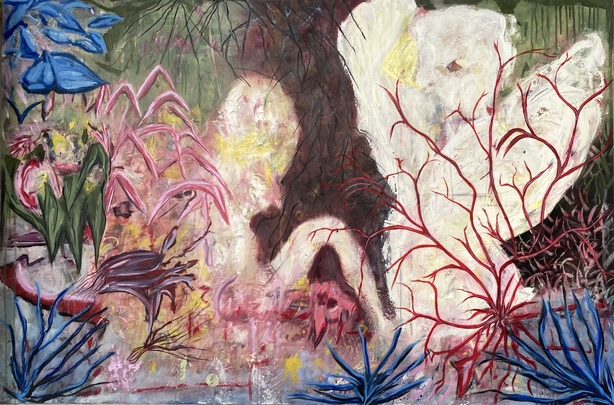
Robin Cherry had wanted to be a painter but art school was not permitted and so he became an architect instead. In 2023, Louise Cherry, now working as an abstract painter, joined life drawing classes to follow in her father’s figurative style, but found that what brought her closer to him was not the act of drawing, rather a more tactile, object-memory-based connection: the blades she used to sharpen her pencils, putty rubbers. She pulled from her shelves art books her father had owned, including one featuring Auguste Rodin's erotic drawings, and books she had used as an art student in Dublin herself. She started thinking again about the nude, the male gaze, and representations of the female body and naked bodies in art and elsewhere. Suddenly the project was no longer about collaboration with her father. "He began to leave the studio", she says. "I gave myself permission to do something different and that’s when I started playing".

She began making cutouts of famous nudes in art, including those featured in works by Tracey Emin and Lynda Benglis. She turned them into stencils and silhouettes. She started thinking about cyberporn and the sexually explicit digital landscape that is part of the everyday background visual culture for twenty-first century teenagers, including her own kids, and how that might relate to a legacy landscape and visual culture of artworld nudes, which is hers.
Although she begins with uncensored gut instinct, she makes conscious decisions about how much to give away explicitly.
The works that have emerged owe a debt to all that has come before, including Cherry's own experiences in life and as an artist. Treating nude figures as flat and cartoon-like but recognisable forms, she began incorporating the body as a negative space into her work. Referencing childhood fables, games and nursery rhymes in some of her titles, she started to unravel the disconnect between child and adult understanding: The snakes won’t catch you on the way down (2024); Red Riding Hood contemplates swimming instead (2024). Taking an instinctive approach, she also began working to find a fruitful meeting point between figurative and abstract representation in her painting.
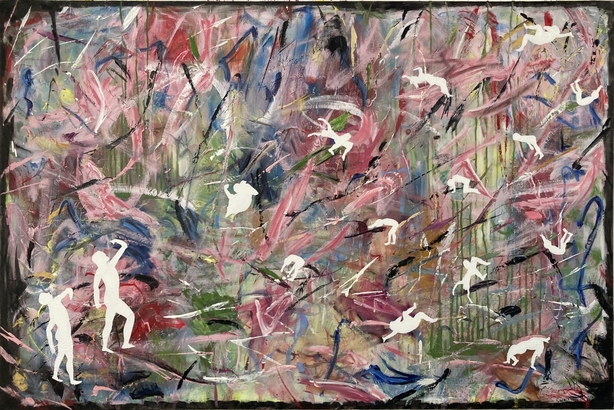
The slow death of the artist (2023) is one of a trio of works that marry language with image directly, as the titles, The slow death of the artist, The digital nanny does it again (2024), and The Garden of Confusion (2024), are painted directly onto each canvas in pink. Digital nanny revisits Lynda Benglis's notoriously shocking and iconic 1974 Artforum Advertisement, for which she posed nude with a dildo. Slow death features a looming, ghostly figure, and more reminders of the many pointers back towards art history and to Cherry’s own wider visual and cultural contexts, references, and inheritances.
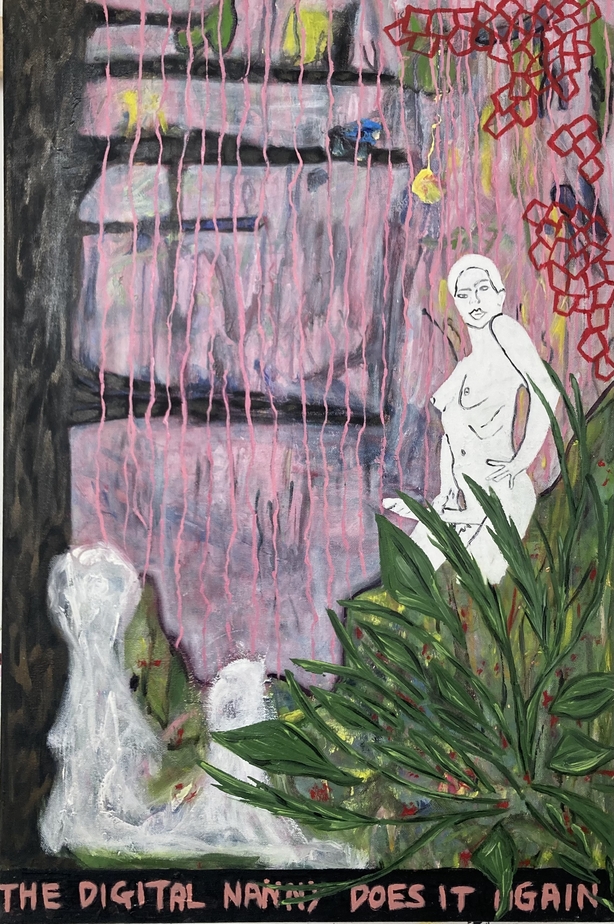
The slow death of the artist could be about Cherry, her father, her relationship with her father, or her relationship with herself or her art. This artist is working her way into the messy thickets of memory and connection, and painting to find her path out. Ghostly forms hover behind the plant-fronds in I promise the sky isn't falling down (2023). In one moment, it appears as though a forlorn and broken seated female figure is being visited by an angel, wings wide in comforting embrace. At another glance, the same female figure appears vulnerable and startled, threatened by an open-mouthed monster. All of this occurs at once in a jungle of sensory overload, where finger-like branches resemble red veins and bloodlines (with visual echoes of the work of Frida Kahlo, who is referenced elsewhere in the show).
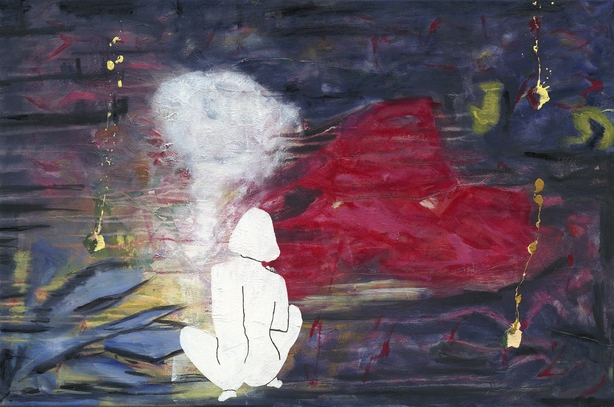
There is violence in the painterly gestures that carry the composition in Throwing the baby out with the bathwater (2023), with its tumbling bodies and the deliberately unchecked busy-ness of each brushstroke. This is layered work, intuitive in its use of colour, physical in its making, imbued with the energy that prompted its origins. A series of small circular paintings, My three Graces (2024), show nude figures trapped behind a network of lines.
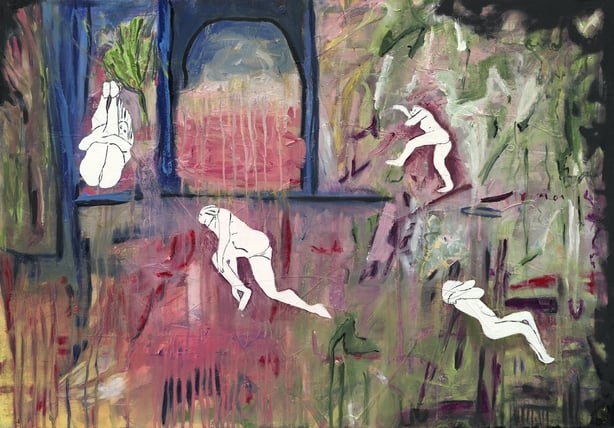
On a technical level, the tension between the female body and the world it occupies seems potentially resolved in four small, collaged and painted self-portraits: Falling - self-portrait as a life drawing I, II, III and IV (2024). But Cherry is working out big themes at large scale too. At a metre and a half wide, Perfecting the art of catfishing (2024) has no nude cutout figures and seems to point towards a narrowing of the conflict between abstraction and representation. It's a muscular painting, an unapologetic one, and it contains much of what she has been working to unravel in and through this work. "There’s a whole world in there underneath that black," she says.
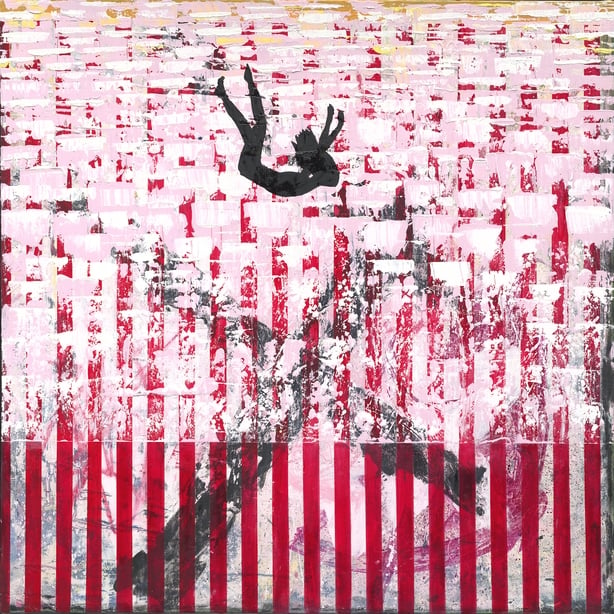
Although she begins with uncensored gut instinct, she makes conscious decisions about how much to give away explicitly. She’s interested in these paintings as a spark for discussion, in the work as a site for conflict, and perhaps confusion, rawness and debate. We and she are encountering cultural and personal demons and ghosts with every gesture she makes. She describes her process as "painting, destroying, painting again… until the final painting is discovered". Experimentation with texture and pigment is important. Her oil and acrylic surfaces are layered with drips and scrapes. There is tension between the chemical makeups of the materials, and a clear understanding of art as physical, psychological, emotional, as much as it is a visual mode of expression. Here is an artist finding freedom and wisdom in a still exploratory space, not exorcising so much as she is carefully exercising the sprits now clambering for presence in her paint.
Louise Cherry: All that's left of you in me is at An Chéad Tine Art Gallery, Kilkenny, from 23 Feb - 25 March 2025, with an opening at 5pm on Sat 22 Feb - find out more here


